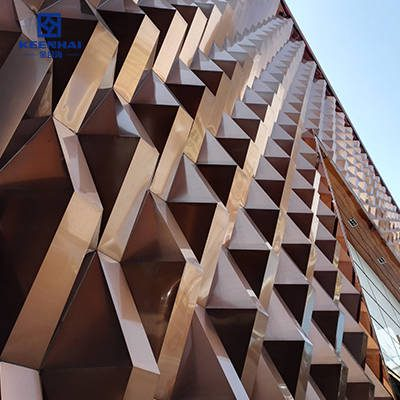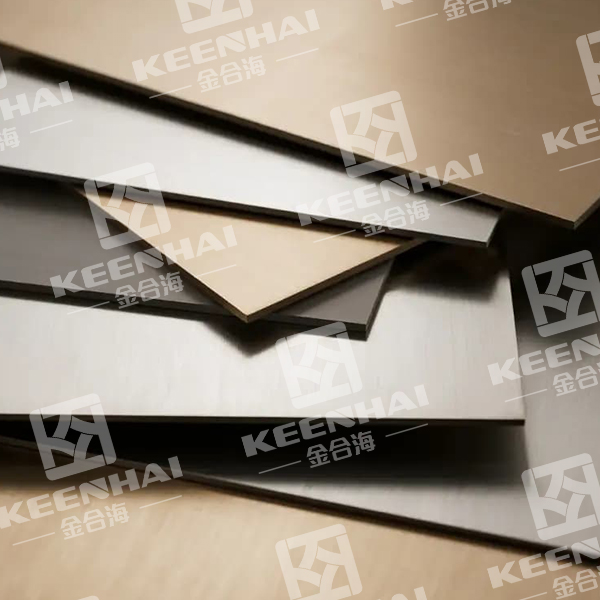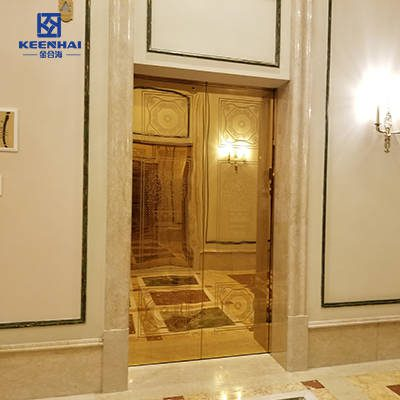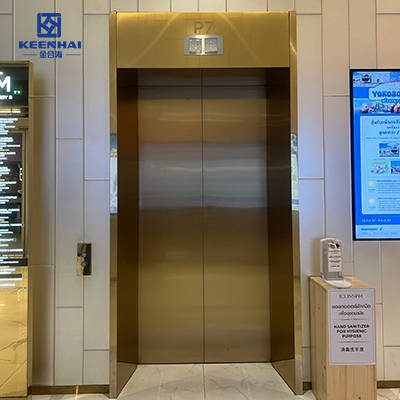The four main types of stainless steel are austenitic, ferritic, martensitic, and duplex. Austenitic is highly corrosion-resistant, ferritic is cost-effective, martensitic is strong and hard, and duplex combines strength with excellent corrosion resistance. Each suits different construction and design needs.
1. Austenitic Stainless Steel
1.1Composition and Key Elements
Austenitic stainless steel is built around a mix of iron, chromium (16–26%), and nickel (6–22%), which gives it unmatched corrosion resistance and long-term durability. Tiny amounts of manganese and nitrogen are often added to improve strength and flexibility. Unlike ferritic or martensitic types, austenitic steel is non-magnetic, making it perfect for sleek, modern architectural applications. For instance, high-end projects often use premium stainless steel products for kitchen surfaces, decorative wall panels, or contemporary interior detailing, where both strength and aesthetic appeal matter. Its resistance to pitting and oxidation ensures these installations stay flawless even in humid or coastal environments.
1.2Mechanical Properties
This steel type is incredibly tough and flexible. You can bend or shape it into complex designs without worrying about cracks, which is why it’s a go-to material for large decorative panels or functional surfaces like countertops and cladding. It also retains toughness at very low temperatures, making it useful in refrigeration and industrial environments. Below is a comparison of key mechanical properties to give a clear sense of its performance:
| Property | Austenitic | Ferritic | Martensitic | Duplex |
|---|---|---|---|---|
| Tensile Strength (MPa) | 520–750 | 450–600 | 600–900 | 600–800 |
| Hardness (HB) | 150–220 | 170–250 | 200–400 | 200–300 |
| 내식성 | Excellent | Good | Moderate | Excellent |
| 자기 | 비자성 | 자기 | 자기 | Slightly Magnetic |
1.3Common Applications
Thanks to its combination of strength, corrosion resistance, and visual appeal, austenitic stainless steel is widely used in modern construction and interior design. You’ll often find it in projects featuring stainless steel exterior facades, custom stainless steel sheet installations, and sophisticated interior detailing like wine cellars or feature walls. For example, a boutique hotel in Singapore installed custom austenitic stainless steel panels on its lobby exterior and wine cellar racks, achieving both durability and a polished, modern look. Long-tail applications such as stainless steel wall panels or stainless steel facade cladding are becoming increasingly popular in urban architecture, where aesthetics and maintenance-free performance are equally important.

2.Ferritic Stainless Steel
2.1Composition and Key Elements
Ferritic stainless steel contains 12–30% chromium and very low carbon, with little to no nickel. This composition gives it excellent resistance to stress corrosion cracking while keeping costs lower than austenitic types. Designers often choose it for architectural panels, HVAC components, and decorative trims because it combines durability with a clean, metallic appearance. A commercial building in Berlin used ferritic panels for its exterior cladding, achieving over 30 years of corrosion resistance without heavy maintenance. Custom stainless steel sheet sections also allow fabricators to match precise dimensions and specifications required for complex facades.
2.2Corrosion Resistance
Ferritic stainless steel performs exceptionally in oxidizing environments but shows moderate resistance in chloride-rich conditions. Its corrosion resistance typically falls between 20–25% chromium content, which protects against rust in urban or light industrial atmospheres. Comparing it with other stainless steel types helps clarify its strengths:
| Property | Ferritic | Austenitic | Martensitic |
|---|---|---|---|
| Chromium (%) | 12–30 | 16–26 | 12–14 |
| Nickel (%) | 0–0.5 | 6–22 | 0–1 |
| Tensile Strength (MPa) | 450–600 | 520–750 | 600–900 |
| 내식성 | Good | Excellent | Moderate |
| 자기 | 자기 | 비자성 | 자기 |
2.3Typical Uses
Ferritic stainless steel thrives in projects where durability and cost-efficiency matter. Architects often use it for stainless steel exterior walls, automotive trim, and kitchen appliances. Installation involves:
-
Measuring and cutting panels to exact building specifications, ensuring alignment with support structures.
-
Surface preparation, including cleaning and polishing to prevent early oxidation.
-
Attachment using stainless fasteners, which maintain integrity without compromising the aesthetic.
-
Final inspection for straightness, fit, and surface uniformity before the building opens or the appliance is shipped.
A modern office complex in Tokyo implemented ferritic stainless steel panels for its façade. Panels measured 2.5 meters by 1.2 meters, delivering a sleek metallic finish, and engineers reported installation time of roughly 4 hours per section. Long-term observation showed minimal discoloration after 8 years of exposure to rain and sunlight. This material choice also lowered construction costs by around 15–20% compared with austenitic options, making it an ideal balance between performance and budget.

3.Martensitic Stainless Steel
3.1Composition and Key Elements
Martensitic stainless steel contains 12–14% chromium and up to 1% carbon, with very low nickel. This composition allows it to achieve high hardness and strength after heat treatment. Engineers often select martensitic steel for cutting tools, knives, and structural components where wear resistance matters. Its ability to be heat-treated makes it ideal for custom stainless steel sheet projects requiring precise mechanical performance. A winery in California used martensitic steel racks in their storage area, providing both structural strength and a sleek, polished look for wine cellars.
3.2Hardness and Strength
Martensitic stainless steel reaches tensile strengths between 600–900 MPa, depending on carbon content and heat treatment. Rockwell hardness typically falls between 40–50 HRC, making it far tougher than ferritic and austenitic types. Its wear resistance ensures long-lasting performance in high-friction applications like industrial blades and surgical instruments. The following table summarizes how martensitic steel compares with other stainless types in key mechanical metrics:
| Property | Martensitic | Austenitic | Ferritic |
|---|---|---|---|
| Tensile Strength (MPa) | 600–900 | 520–750 | 450–600 |
| Hardness (HB) | 200–400 | 150–220 | 170–250 |
| 내식성 | Moderate | Excellent | Good |
| 자기 | 자기 | 비자성 | 자기 |
3.3Typical Applications
Martensitic stainless steel excels in projects where hardness and structural reliability are crucial. Architects and engineers use it for staircases, handrails, and high-wear façade components. Installation steps include:
-
Precision cutting to match design specifications and tolerances.
-
Heat treatment to achieve the desired hardness and strength.
-
Surface finishing, which may include brushing or polishing to improve aesthetics and corrosion resistance.
-
Structural assembly, ensuring that supports and fasteners align perfectly to handle stress and load.
For example, a commercial building in Munich used martensitic stainless steel for its handrails and outdoor staircases, where panels measured 2 meters in height and 1.5 meters in width, delivering both durability and a visually striking metallic finish. Maintenance inspections after 5 years showed no noticeable wear or deformation, while the installation cost remained within the projected budget, highlighting its efficiency for high-traffic areas. Long-tail applications like 스테인리스 스틸 외부 클래딩 or custom stainless steel sheet panels also benefit from its toughness, making it a reliable choice in demanding environments.

4.Duplex Stainless Steel
4.1Composition and Key Elements
Duplex stainless steel combines roughly 22% chromium, 5–6% nickel, and 3% molybdenum, blending the best qualities of austenitic and ferritic types. This hybrid composition gives it excellent strength, toughness, and corrosion resistance, particularly against chloride-induced corrosion. Designers often choose duplex steel for architectural facades, industrial piping, and coastal structures, where performance and longevity matter. For instance, a luxury seaside resort in Miami used duplex panels for its 스테인리스 스틸 외벽 installations, achieving a visually striking look while ensuring durability against salty air and high humidity.
4.2Advantages over Other Types
Duplex stainless steel provides roughly double the tensile strength of standard austenitic steel, while maintaining good ductility and toughness. Its resistance to stress corrosion cracking outperforms both ferritic and martensitic types, making it ideal for structural applications. Key performance parameters include:
| Property | Duplex | Austenitic | Ferritic |
|---|---|---|---|
| Tensile Strength (MPa) | 600–800 | 520–750 | 450–600 |
| Yield Strength (MPa) | 450–650 | 215–275 | 200–300 |
| 내식성 | Excellent | Excellent | Good |
| 자기 | Slightly Magnetic | 비자성 | 자기 |
4.3Common Applications
Duplex stainless steel works best in projects requiring both strength and corrosion resistance. Architects frequently use it for stainless steel exterior facades, coastal bridges, and chemical processing plants. Installation involves:
-
Precision measurement and panel cutting to match structural frameworks.
-
Surface finishing using brushing or polishing techniques to enhance corrosion resistance and visual appeal.
-
Fastener and joint installation, ensuring alignment with load-bearing requirements.
-
Inspection and quality assurance, confirming that mechanical performance meets specifications.
A commercial office building in Sydney used duplex stainless steel for its facade cladding, with panels measuring 3 meters by 1.5 meters. Installation took roughly 5 hours per section, and the building now benefits from low maintenance costs 그리고 over 25 years of corrosion protection. Duplex’s combination of strength, durability, and aesthetic appeal also supports long-tail applications like stainless steel facade cladding 그리고 stainless steel wall panels, making it highly versatile for demanding architectural and industrial environments.
Already picked the right grade? Learn how to give it long-lasting color and extra hardness with our complete guide: What is a PVD stainless steel sheet?







